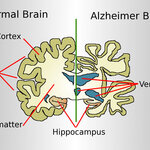Neuroscience

Fifty years ago, the philosopher and linguist Noam Chomsky speculated that humans are able to learn language easily as children because knowledge of grammar is 'hardwired' into human brains. In other words, we know some of the fundamental things about human language at birth, without ever being taught.
Controversial? Yes, but a group of cognitive scientists now say he may have been onto something. They contend we are born with knowledge of certain syntactical rules that make learning human languages easier.
In their study, a small, green, cartoonish 'alien' named Glermi taught…

Scientists have identified a biochemical abnormality behind the potentially fatal neurodegenerative Machado-Joseph disease (MJD) and, using several models of the disease, were able to reverse the problem in what may be a crucial step towards a cure for humans. Currently, the disease is incurable and the patients’ increasing neurodegeneration cannot be stopped.
In the study in the journal Brain, autophagy - literally meaning “self-devouring” and the mechanism used by cells to eliminate their unwanted molecules and structures - was found to be “blocked” in MJD due to a lack of a…

A new study of electroencephalography (EEG) readings published in the Journal of Neuroscience says that despite the major neural overhaul underway during adolescence, most teens maintained a unique and consistent pattern of underlying brain oscillations. They say this lends a new level of support to the idea that people produce a kind of brainwave "fingerprint."
They recruited 19 volunteers who were 9 or 10 years old and 26 who were 15 or 16 years old to sleep for two consecutive nights in the lab while EEG electrodes recorded oscillations in their brains during both REM and non-REM…

A group of patients withneurodegenerative diseases have helped researchers discover a neurological basis of embarrassment. The thumb-sized bit of tissue in the right hemisphere of the front part of the brain is called the pregenual anterior cingulate cortex and they found the link using...karaoke.
They recorded people belting out "My Girl" – the 1964 hit by The Temptations - and then asked them to listen to their own singing without the accompanying music. The degree to which the singers were embarrassed in hearing themselves sing depended on the integrity of the…

Recent research indicates that bilingual speakers can outperform monolinguals in certain mental abilities, such as editing out irrelevant information and focusing on important information, said Judith Kroll, Distinguished Professor of Psychology, Penn State. These skills make bilinguals better at prioritizing tasks and working on multiple projects at one time. Kroll said that these findings counter previous conclusions that bilingualism hindered cognitive development.
"We would probably refer to most of these cognitive advantages as multi-tasking," said Kroll, director of the Center…

A new study in Proceedings of the Royal Society B says it is the first to demonstrate that birds possess empathy - and they say they have verified it using both behavioral and physiological methods to measure these traits.Using non-invasive physiological monitoring, the researchers say domestic hens show a clear physiological and behavioral response to their chicks' distress. During one of the controlled experiments, when the baby chicks were exposed to a puff of air, the hens' heart rate increased and eye temperature decreased. The hens also changed their behavior and reacted with…

A new study will see researchers from the University of East London using eye-tracking technology to establish if future language, social and attention weaknesses can be identified in babies as young as six-months.
Being able to predict weaknesses in the critical pre-school years would enable professionals to develop targeted interventions, and increase the long-term chances that babies born in some of the UK's most deprived areas can enter school with an equal chance of success.
It is the first time a study of this kind has been taken directly into the community through Children's…

If you saw the film version of "Mamma Mia!" you may have wondered why some of the actors could act, sing and dance and some, clearly, could not.
A new study in Current Biology says that people who are fast to learn a simple sequence of finger motions, like a piano piece, or quick to pick up dance numbers, are also those whose brains show large changes in a particular chemical messenger, gamma-aminobutyric acid(GABA), following electrical stimulation. GABA is important for the plasticity of the motor cortex, a brain region involved in planning, control, and execution of voluntary…

A preliminary study in JAMA (JAMA. 2011;305[8]808-814.) has found that 50-minute cell phone use was associated with increased brain glucose metabolism, a marker of brain activity, in the region closest to the phone antenna, but that is not known to have any clinical significance.
"The dramatic worldwide increase in use of cellular telephones has prompted concerns regarding potential harmful effects of exposure to radiofrequency-modulated electromagnetic fields (RF-EMFs). Of particular concern has been the potential carcinogenic effects from the RF-EMF emissions of cell phones. However,…

How do we 'experience' our own bodies? It has long been believed that our body image is limited by our innate body plan, so we cannot truly experience having more than one head, two arms and two legs but brain scientists at the Swedish medical university Karolinska Institutet say they have shown that it is possible to make healthy volunteers experience having three arms at the same time.
In a PLoS ONE aper they describe how it is possible to create an illusion of owning three arms, under controlled conditions in a laboratory. Their experiment involved participants sitting at a…